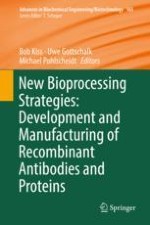2018 | OriginalPaper | Buchkapitel
High-Throughput Process Development for Biopharmaceuticals
verfasst von : Abhinav A. Shukla, Shahid Rameez, Leslie S. Wolfe, Nathan Oien
Erschienen in: New Bioprocessing Strategies: Development and Manufacturing of Recombinant Antibodies and Proteins
Aktivieren Sie unsere intelligente Suche, um passende Fachinhalte oder Patente zu finden.
Wählen Sie Textabschnitte aus um mit Künstlicher Intelligenz passenden Patente zu finden. powered by
Markieren Sie Textabschnitte, um KI-gestützt weitere passende Inhalte zu finden. powered by
